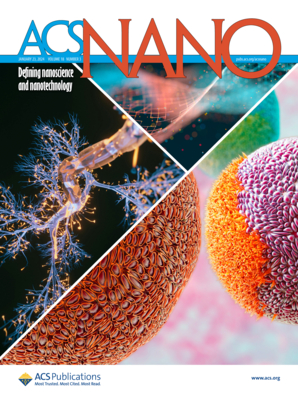Atomically Precise Control of Topological State Hybridization in Conjugated Polymers
IF 15.8
1区 材料科学
Q1 CHEMISTRY, MULTIDISCIPLINARY
引用次数: 0
Abstract
Realization of topological quantum states in carbon nanostructures has recently emerged as a promising platform for hosting highly coherent and controllable quantum dot spin qubits. However, their adjustable manipulation remains elusive. Here, we report the atomically accurate control of the hybridization level of topologically protected quantum edge states emerging from topological interfaces in bottom-up-fabricated π-conjugated polymers. Our investigation employed a combination of low-temperature scanning tunneling microscopy and spectroscopy, along with high-resolution atomic force microscopy, to effectively modify the hybridization level of neighboring edge states by the selective dehydrogenation reaction of molecular units in a pentacene-based polymer and demonstrate their reversible character. Density functional theory, tight binding, and complete active space calculations for the Hubbard model were employed to support our findings, revealing that the extent of orbital overlap between the topological edge states can be finely tuned based on the geometry and electronic bandgap of the interconnecting region. These results demonstrate the utility of topological edge states as components for designing complex quantum arrangements for advanced electronic devices.

共轭聚合物拓扑状态杂化的原子级精确控制
最近,在碳纳米结构中实现拓扑量子态已成为承载高度相干和可控量子点自旋量子比特的一个前景广阔的平台。然而,对它们的可调操纵仍然难以实现。在这里,我们报告了对自下而上制造的π共轭聚合物中拓扑界面出现的拓扑保护量子边缘态杂交水平的原子级精确控制。我们的研究结合了低温扫描隧道显微镜和光谱学以及高分辨率原子力显微镜,通过选择性脱氢反应有效地改变了五碳烯基聚合物中分子单元相邻边缘态的杂化水平,并证明了它们的可逆性。我们采用密度泛函理论、紧密结合和哈伯德模型的完整活性空间计算来支持我们的发现,结果表明拓扑边缘态之间的轨道重叠程度可以根据互连区域的几何形状和电子带隙进行微调。这些结果证明了拓扑边缘态作为设计先进电子器件复杂量子排列的元件的实用性。
本文章由计算机程序翻译,如有差异,请以英文原文为准。
求助全文
约1分钟内获得全文
求助全文
来源期刊

ACS Nano
工程技术-材料科学:综合
CiteScore
26.00
自引率
4.10%
发文量
1627
审稿时长
1.7 months
期刊介绍:
ACS Nano, published monthly, serves as an international forum for comprehensive articles on nanoscience and nanotechnology research at the intersections of chemistry, biology, materials science, physics, and engineering. The journal fosters communication among scientists in these communities, facilitating collaboration, new research opportunities, and advancements through discoveries. ACS Nano covers synthesis, assembly, characterization, theory, and simulation of nanostructures, nanobiotechnology, nanofabrication, methods and tools for nanoscience and nanotechnology, and self- and directed-assembly. Alongside original research articles, it offers thorough reviews, perspectives on cutting-edge research, and discussions envisioning the future of nanoscience and nanotechnology.
 求助内容:
求助内容: 应助结果提醒方式:
应助结果提醒方式:


